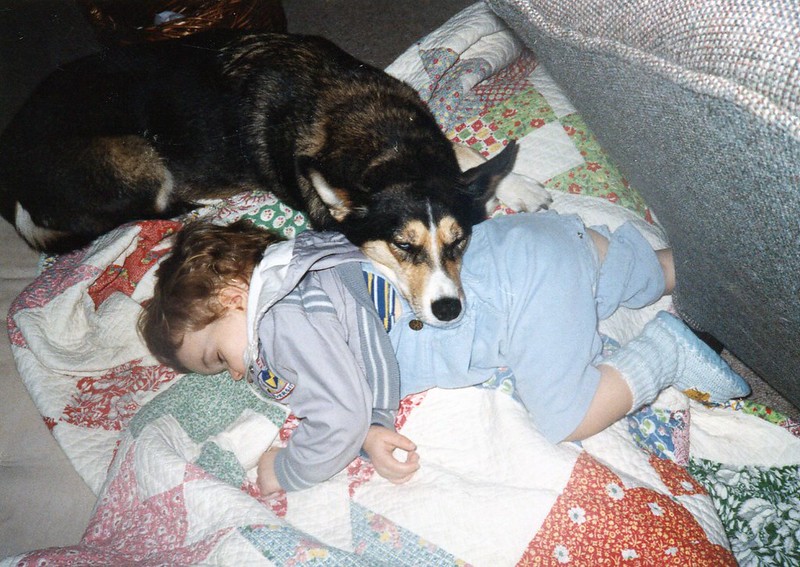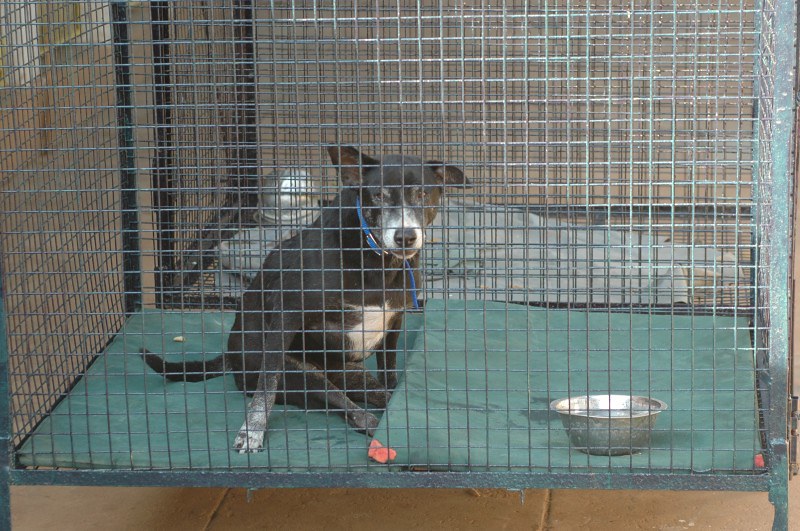Imagine a world in which all dogs go to heavens known as Home. Home is where the humans have evolved beyond viewing dogs as property, or as subordinate members of the household. Home is where the humans practice life-long learning, and understand the difference between reinforcers and bribes. Home is where one dog is gathered round by all the other dogs at nail trimming time—because now nail trims predict every dog’s favorite form of reinforcement. The days of pinning down a dog are gone. The days of shock and prong and choke collars are gone. The days of kicks and flicks and spinning bound* are gone. All the horrors unmentioned are gone. Home is where the phrase “entitled to the dog” has been replaced with the phrase “devoted to the dog.”

This is the war cry of one seeking change away from aggression and toward kindness and gentleness.
Bizarre, the expectations of us humans that our dogs should somehow understand and follow human rules and mores as if our dogs were human. Given how our species rails against anthropomorphism—e.g., “dogs are not children!” is a common chide—you’d think we’d respect the differences between dogs and humans. Among modern adults, the anthropomorphic charge often is little more than a socially-approved device for dismissing the needs of non-human animals.
Consider, for example, aggression. It’s no coincidence that aggression calls make up the bulk of my and many other dog behavior consultants/trainers’ calls. Since dogs don’t have texting—no thumbs—they settle their disputes with a variety of threat displays and sometimes biting. In the dog world, these disputes are often minor and soon forgotten, but we humans take threats and physical altercations seriously. Perhaps we partake in projection.
In her book The Culture Clash, Jean Donaldson points out that biting is a natural, normal behavior for dogs. Unfortunately for them, stigmatizing non-human animals is typical behavior for us humans. “There is incredible stigma attached to dogs that bite,” says Donaldson, “as though they have character flaws and are qualitatively different from dogs who have never bitten. They are not. There are not two kinds of dogs: nice dogs who would never bite and less nice dogs who do.”
Don’t panic—this does not mean dogs are readying to bite you. But being captive animals means no ability to flee from danger, which means that dogs have limited options for protecting themselves from threats. Dogs are at our mercy. That makes us responsible for ensuring that they are not put in situations where they feel their only option is to defend themselves. And that means we humans also are responsible for ensuring that our own species knows how to behave around these animals in ways that do not scare them or otherwise result in them feeling threatened.

But instead, says Donaldson, we hold an absurd ideal that dogs should never, ever bite. (Never mind that the average human thinks nothing of pulling them, pushing them, allowing them to be yanked and poked and ridden as if carnival toys, confining them, cornering them, collar choking them, and much worse.)
We set up our beloved dogs for doom by expecting them to protect us from danger yet not be dangerous to us. As Donaldson suggests, our tendency to believe that our dogs “can tell the good guys from the bad guys” is a sad and ultimately fatal myth—of epidemic proportions when we consider how many dogs are abandoned and euthanized every year, having been charged with aggression and other behavior problems. Put in Donaldson’s words, “We routinely execute dogs who bite….I say execute rather than euthanize because a biting dog is not suffering and does not need or want a merciful death. He is killed because of transgressions he has committed against humans. That’s what an execution is for.”**
I am ever-cautious to protect my dogs from situations that might put them at risk of having to defend themselves from a charging dog or an aggressive person, or one who doesn’t understand dog behavior and subtle provocation. I try to encourage the same in my clients as well, since self-preservation behavior such as biting tends to fracture dog-human relationships. Without opposable thumbs, all our canine friends have for tools are teeth, but for the most part, we have not adjusted for their thumblessness. Perhaps, as a whole, we are not able to do so—not yet.

Yet many exist who are willing and ready to adjust. They may speak softly on the topic if at all, perhaps enacting their own forms of self-protection, since a majority opinion can be relentless in its silencing effect of more open-hearted, logically-considered positions and actions toward improvements for companion canines and their caretakers. Some may view the station of dogs in society as evidence that we are heading toward, if not already (still) in, an animal welfare crisis. Some have proposed brave, daring roads to relieving that crisis. A paraphrase from Antoine de Saint-Exupéry provides just one rationale for why we should dare: We are responsible forever for those whom we have tamed.
Various movements have been promoted and methods implemented and offered as solutions to the crisis. The practice of placing companion animals in unverified homes*** is one of these. But it did not and does not solve the crisis. First called “open adoption” (the title is misleadingly reminiscent of open adoption for human children, while in reality being quite the opposite both philosophically and methodologically), next it was re-named “conversational adoption,” a label suggesting friendliness. This name is going out of style too, however, as myriad companion animal rescue/sheltering and placement charities have pointed out that it is equally misleading, attempting to imply that organizations not in support of unverified placement practices would refuse conversations and friendly relationships with adopters, which is patently untrue.
Most recently the movement has been re-named “education-based adoption”—perhaps the most insidious re-branding so far in its implicit yet once again untrue claim that animal adoption organizations doing anything other than unverified placements are either not offering education, or are not educated—or both. Adding insult to injury are a few very thinly evidenced claims, focused not on animal protection but rather on adopter satisfaction with ease of adoption and other measures of the adopters’ happiness rather than the adoptees’ safety and well-being. These claims are made in “studies” by proponents of unverified placement practices, while support for programs and studies to show the efficacy of other, more animal-protection-centric options seems non-existent. Sometimes, when the animal protection-centric opinion starts to gain a foothold, the adopter-centric camp lobs fabrications in attempts to diminish the other side. “Fear-based” and “angry” are typical accusations, but there have been damaging personal attacks on individuals as well.

In the face of all of this we hold fast and say again, we are responsible forever for those whom we have tamed. Too many of us continue to put much, if not all, of the expectations and responsibility on the already disadvantaged and marginalized animals who have come to rescue/shelter groups as a result of a public trust in us to care for and protect these animals. We have been expecting the animals who need our help to instead carry our water, when we signed up to carry theirs. There are many reasons that the unverified placement and similar models don’t work in companion animal microcosms, but furthermore, they don’t work for the macrocosm, and here’s why: We, the humans, are the ones in need of interventions. We have a macrocosmic problem in need of a macro solution. We need to be educated, trained, and prepared to be adopters. And if we are, there is no reason on earth why we shouldn’t be willing to demonstrate it in advance. We demonstrate our ability to properly handle a car before we’re allowed to drive. More similarly, if we must demonstrate fitness before adopting a child, surely we can see our way clear to accepting the call to fitness for adopting a helpless animal who would be at our complete mercy. Our kids learn to call 911 if ever they are in danger, but our dogs do not have that luxury. If a dog is being threatened or harmed, s/he can’t just wait until the perpetrator is away and then call for help or tell a trusted person.
The next step toward solving the crisis in companion animal welfare is at once excitingly innovative and frustratingly obvious: a human-to-human offering in which we gift every adopter with anti-aversive training and behavior literacy (TBL), as part of the adoption process. Training the animals housed in rescues and shelters is fine, but it isn’t the solution. Once the animal moves out of the shelter or rescue, s/he is immediately immersed in a variety of potentially distressing new stimuli, which means a high likelihood of reactive behaviors in response to the distressing new stimuli. The animal’s new caretaker needs to be ready to take appropriate, positive steps to either prevent reactions or resolve them as they occur. Traditionally, what has happened instead is either 1) the animal is let to suffer without help, 2) the animal’s new caretaker attempts to resolve the problem using harmful methods that, had TBL been obtained, could have been avoided because the caretaker would have known that those methods would make the problem worse, or 3) the caretaker tolerates the problem until s/he can take no more, then returns the animal or surrenders, sells, abandons, gives away, abandons, or euthanizes them.

Attempts have been made to triage these situations via email messaging, templated webinars, or text-based, automated advice services. A few shelters and rescues will send a volunteer or staff member to the new adopter to offer help, but this is generally not effective long-term as no shelter can send a trainer or behavior consultant weekly until all problems resolve. Nor will most adopters want to spend thousands on reputable professional dog behavior services; the result then is either no help at all, or inexpensive help which is often either ineffective or outright abusive and dangerous to the animal. But if the adopter is given foundational knowledge and skills needed to prepare him to address problems in advance of need, the animal’s chances of not only recovering from the distress and resultant behavior concern, but of being allowed to remain in the new home with the adopter, are much better. This then reduces the likelihood of another surrender. The ultimate result is a relief to the entire sheltering and rescue system, and increased well-being and happiness for adoptees and adopters alike. There’s also the eventual decrease in the cultural heartbreak that comes from being part of a society whose beloved companion animals live under constant threat that the revolving doors of suffering and surrender will yet again recall them.
The way to truly help homeless companion animals now and into the foreseeable future, in a way that seals, not just temporarily barricades, the revolving doors of surrender-suffering-surrender is to decrease their need for help, by transforming adopters into skilled, responsible companion animal caretakers. For every animal whose organization and adopter embraces this innovation, one revolving door could be stilled forever. It’s a societal commitment that we need to achieve. What society is better equipped to achieve it than ours?
*A reference to the abusive practice known as “helicoptering”
**This is not to minimize serious occurrences where death or mutilation have resulted. Donaldson distinguishes between serious bites and those that result in something more akin to kitchen injuries: “No effort is made to distinguish dogs involved in fatal and near fatal maulings from kitchen injury level biters. In human terms, this is exactly akin to lumping sharp words with felony assault and murder.”
***Unverified homes: details of home unconfirmed during adoption process, such as address, safety for the animal, household composition or desire for the animal, landlord permission, etc. (These are just a few examples.)
Featured image: a woman and dog look out at the view together. Image credit Wolf Gordon Clifton / Animal People, Inc.





